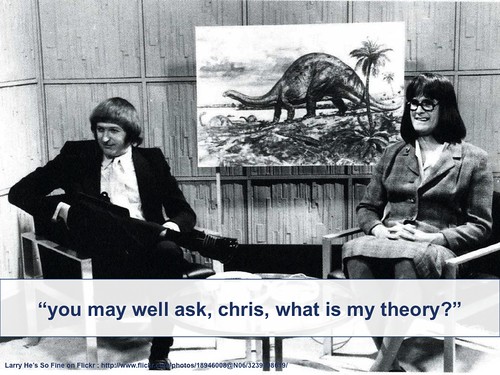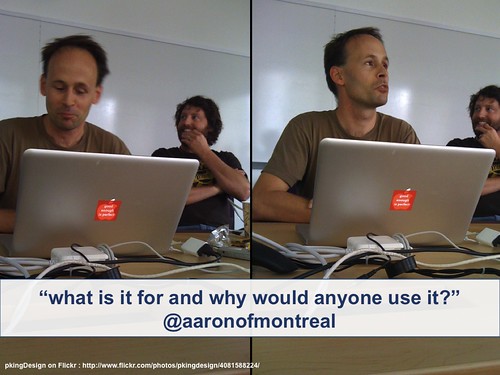Where 2.0 - Hype (or Local?)
Sometimes writing a talk and putting together an accompanying slide deck is an education in itself. You set out with a point you want to make and in researching the evidence to back up your assertions you find out that the point you originally wanted to make isn't actually correct. You could give up at this point, which is not to be recommended as you're already on the conference schedule, or you could accept that your reasoning was flawed in the first place and make your talk instead centre on why you were wrong.
Thus it was with the researching and background behind my talk at Where 2.0 in San Jose on Wednesday. Originally entitled as a declaration, it soon became obvious that "Ubiquitous location, the new frontier and hyperlocal nirvana" was missing a very significant question mark.
The audience seemed a trifle bemused when I told them that the talk was brought to them "by the number three and the word local (hyper and micro)", but when I mentioned that it included "a theory" a Mexican wave of shoulder slumping swept the (packed) room, followed in short succession by a long sigh.
I couldn't blame them.
Luckily attention perked up when I mentioned that it was my Theory of Stuff (Stuff? Stuff? Huh?) and illustrated this point with a scene from the classic Monty Python Anne Elk (Miss) and her Theory sketch.
So, to the talk. Just as "the wonderful thing about standards is that there are so many of them to choose them" (apocryphally attributed to Grace Hopper), the wonderful thing about hyperlocality is that it has so many definitions, but a summation of these seem to agree on:
- entities and events located in a well defined, community area
- intended for consumption by residents of or visitors to that area
- created by a resident of or visitor to that area
That's three elements and continuing the number three, hyperlocality needs to overcome three matching hurdles, three geo hurdles and three location hurdles
- the ability to have scannable, parseable content
- the ability to join users to the content
-
the ability to determine what is local and what isn't in that content
-
the ability to scan and parse content for geographic references
- the ability to determine where a user is located
-
the ability to determine what is local to a user and what isn't relative to the user
-
the ability to use IP location
- the ability to use GPS
- the ability to use A-GPS
(the third one there is an artifact of the need to make the "number three meme" work and I throw my hands up in surrender for that piece of artifice. Mea culpa)
While we're on the subject of the "number three meme" there's also three genera of hyperlocality
- "classic" hyperlocal; taking, refining and creating local news (
outside.in, Patch) - "corporate" hyperlocal; where a corporation removes their brand to fit in with the local community (Starbucks and the 15th Avenue Coffee and Tea in NYC)
- "user" hyperlocal; creating and delivering localised content and information based on checking in (Foursquare, Gowalla, Rummble, etc)
The meme continues with the level of granularity at which hyperlocal services operate:
- "local", at county level (Washington Post / Loudon)
- "hyperlocal", at city of neighbourhood level (Placeblogger)
- "microlocal", at block level (Everyblock)
So far, so (hyper)local. There's good exemplars of all of the above, in operation, right now. But there's also several elephants in the room, looming large and waving their trunks for attention.
Is location that ubiquitous? We all say it is but where's the proof? So 21% of mobile handsets are classed as smartphones (though not all of those have location capabilities), what about the remaining 79%. That's not that ubiquitous is it?
Then there's the issues of location and privacy; when location enablers such as Yahoo's Fire Eagle and Google's Latitude were launched we had lots of hand waving, foot stamping and Big Brother references from privacy activists, some of which was warranted, some of which were just pleas for publicity.
Most matching of users and content and ad inventory is dependent on technologies which derive location from an IP address. That's simply not good enough for hyperlocal coverage where the difference between an IP location and a GPS location can be over 10 miles; that's not even local let alone hyper or micro local.
User hyperlocal isn't without problems either. Gowalla won't let you check in unless your GPS lock agrees with the location of a place, eliciting cries of "but I'm here dammit". Yelp has ... issues on how it undertakes hyperlocal. Foursquare allows you to become Mayor of The North Pole from the confort of your own sofa and Fake Mayor on the iPhone bypasses Foursquare altogether.
So the outlook for hyperlocal is all hype then, obviously?
Well not quite. The number of location capable smartphones will continue to grow with 5 million mobile handsets predicted by 2011. Foursquare is growing at a phenomenal rate hitting the 1 check in per second mark recently. 33% of us now read and consume news from a mobile handset and we seem to be quite happy with displaying our location history via check ins, a far cry from the location hysteria of 2 years ago.
This year at Where 2.0 the view of the geo-scape was significantly different from the previous year; I don't doubt that will be the same for Where 2.0 in 2011. See you all there.

